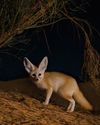All that glitters
BBC Wildlife
|September 2021
Dazzling in flight and in colour, hummingbirds have long captured our imagination. But these spectacular birds are vulnerable to a changing world.
His heart has slowed from a daytime rate of 1,200 beats per minute to less than 100 beats per minute, which, for a hummingbird, is barely ticking over. His body temperature has dropped too, by some 26°C, to just a few degrees above the chilly ambient air temperature. To put that into perspective, were our body temperature to drop by 2°C, we’d enter a state of hypothermia. To all intents and purposes, this hummingbird is coming out of a state of near hibernation.
Fuel in the tank
Extremes of exertion demand a lot of energy. The recommended daily calorie intake is 2,500 for men and2,000 for women. But if we had the metabolism and energy requirements of a hummingbird, it would increase to approximately 155,000 calories a day. Nectar from flowers is sugar-rich and provides the energy hummingbirds need. They cannot, however, live on sugar alone – they supplement their daily diet with protein in the form of small insects and spiders, which they hunt when not visiting flowers.
Rise and shine
This story is from the September 2021 edition of BBC Wildlife.
Subscribe to Magzter GOLD to access thousands of curated premium stories, and 10,000+ magazines and newspapers.
Already a subscriber? Sign In
MORE STORIES FROM BBC Wildlife

BBC Wildlife
"I was terrified the elephant would ram us"
African elephant in Kenya
2 mins
January 2026

BBC Wildlife
ALL YOU EVER NEEDED TO KNOW ABOUT THE Fennec fox
THE FENNEC FOX IS THE SMALLEST fox in the world, with a body length that can be as little as 24cm.
3 mins
January 2026

BBC Wildlife
INTO THE PLASTISPHERE
A unique synthetic ecosystem is evolving in our oceans – welcome to the plastisphere
7 mins
January 2026

BBC Wildlife
“More than half of all animal life exists in a parasitic relationship, and all life lives in symbiosis”
Our survival depends on species evolving to live together - but some relationships take dark turns
7 mins
January 2026

BBC Wildlife
Are animals able to dream?
SLEEP IS A MYSTERIOUS THING. FOR A long time, we weren't sure why we do it.
1 mins
January 2026

BBC Wildlife
Does a cuckoo know it's a cuckoo?
ABSURD LITTLE BIRDS ACROSS THE world lay their eggs in the nests of other species, leaving the hapless parents to raise a changeling at the expense of their own offspring.
2 mins
January 2026

BBC Wildlife
Orcas killing young sharks
Juvenile great whites are easy prey for orca pod
1 mins
January 2026

BBC Wildlife
Ocean goes on tour
Acclaimed film touring the UK, backed by live orchestra and choir
1 min
January 2026

BBC Wildlife
Feisty bats hunt like lions
Winged mammals use a 'hang and wait' strategy to take down large prey
1 mins
January 2026

BBC Wildlife
SNAP-CHAT
Richard Birchett on magical merlins, wily coyotes and charging deer
2 mins
January 2026
Translate
Change font size

